engine KIA Sephia 2008 2.G Owners Manual
[x] Cancel search | Manufacturer: KIA, Model Year: 2008, Model line: Sephia, Model: KIA Sephia 2008 2.GPages: 298, PDF Size: 5.38 MB
Page 285 of 298
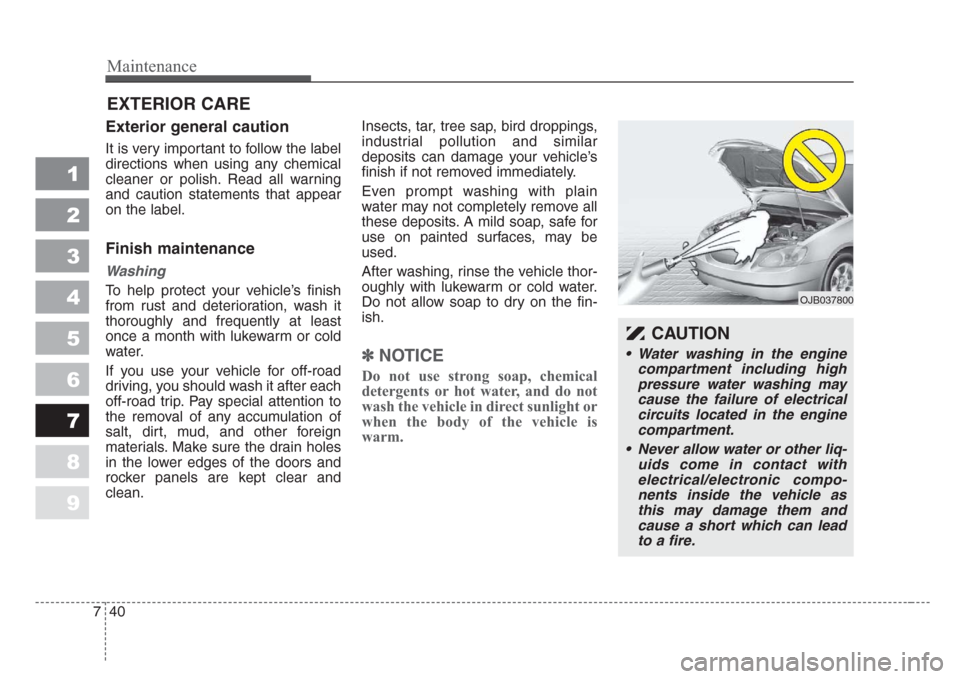
Maintenance
40 7
1
2
3
4
5
6
7
8
9
EXTERIOR CARE
Exterior general caution
It is very important to follow the label
directions when using any chemical
cleaner or polish. Read all warning
and caution statements that appear
on the label.
Finish maintenance
Washing
To help protect your vehicle’s finish
from rust and deterioration, wash it
thoroughly and frequently at least
once a month with lukewarm or cold
water.
If you use your vehicle for off-road
driving, you should wash it after each
off-road trip. Pay special attention to
the removal of any accumulation of
salt, dirt, mud, and other foreign
materials. Make sure the drain holes
in the lower edges of the doors and
rocker panels are kept clear and
clean.Insects, tar, tree sap, bird droppings,
industrial pollution and similar
deposits can damage your vehicle’s
finish if not removed immediately.
Even prompt washing with plain
water may not completely remove all
these deposits. A mild soap, safe for
use on painted surfaces, may be
used.
After washing, rinse the vehicle thor-
oughly with lukewarm or cold water.
Do not allow soap to dry on the fin-
ish.
✽
NOTICE
Do not use strong soap, chemical
detergents or hot water, and do not
wash the vehicle in direct sunlight or
when the body of the vehicle is
warm.
CAUTION
• Water washing in the engine
compartment including high
pressure water washing may
cause the failure of electrical
circuits located in the engine
compartment.
• Never allow water or other liq-
uids come in contact with
electrical/electronic compo-
nents inside the vehicle as
this may damage them and
cause a short which can lead
to a fire.
OJB037800
Page 293 of 298
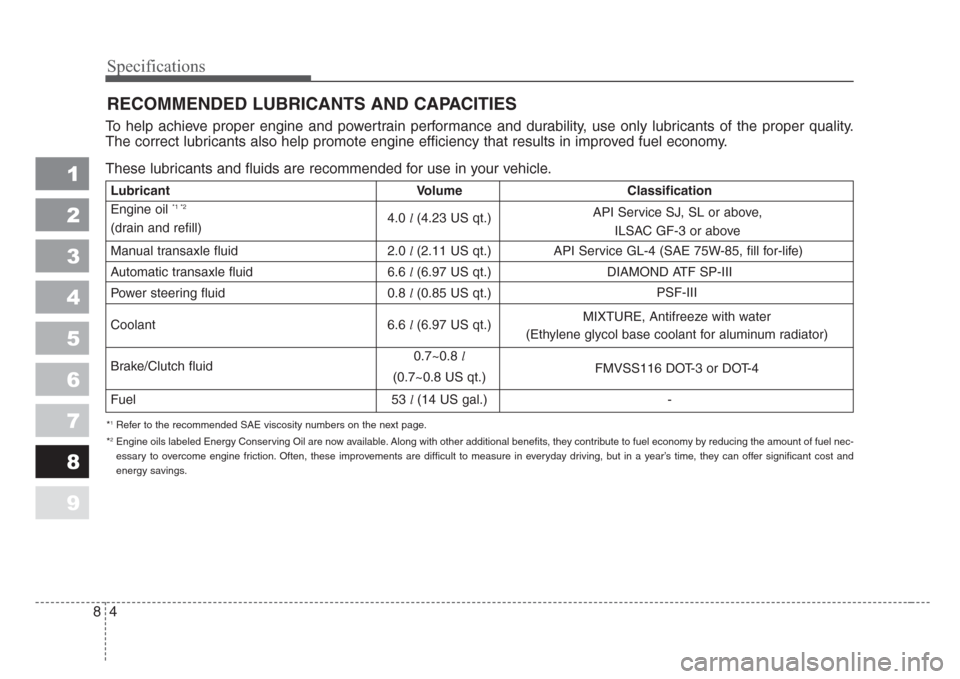
Specifications
4 8
1
2
3
4
5
6
7
8
9
RECOMMENDED LUBRICANTS AND CAPACITIES
To help achieve proper engine and powertrain performance and durability, use only lubricants of the proper quality.
The correct lubricants also help promote engine efficiency that results in improved fuel economy.
These lubricants and fluids are recommended for use in your vehicle.
*1Refer to the recommended SAE viscosity numbers on the next page.
*
2Engine oils labeled Energy Conserving Oil are now available. Along with other additional benefits, they contribute to fuel economy by reducing the amount of fuel nec-
essary to overcome engine friction. Often, these improvements are difficult to measure in everyday driving, but in a year’s time, they can offer significant cost and
energy savings.
Lubricant Volume Classification
Engine oil
*1 *2
4.0l(4.23 US qt.)
(drain and refill)
Manual transaxle fluid 2.0 l(2.11 US qt.)
Automatic transaxle fluid 6.6 l(6.97 US qt.) DIAMOND ATF SP-III
Power steering fluid 0.8 l(0.85 US qt.)
Coolant 6.6 l(6.97 US qt.)
Brake/Clutch fluid0.7~0.8l
(0.7~0.8 US qt.)
Fuel 53 l(14 US gal.) -API Service SJ, SL or above,
ILSAC GF-3 or above
API Service GL-4 (SAE 75W-85, fill for-life)
PSF-III
FMVSS116 DOT-3 or DOT-4 MIXTURE, Antifreeze with water
(Ethylene glycol base coolant for aluminum radiator)
Page 294 of 298
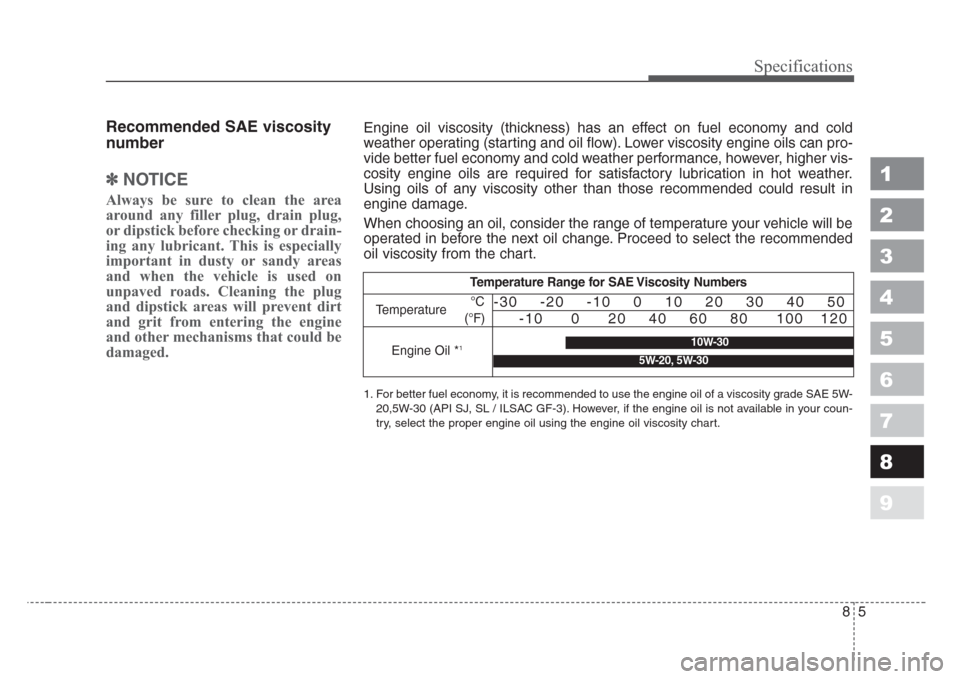
85
1
2
3
4
5
6
7
8
9
Specifications
Recommended SAE viscosity
number
✽
NOTICE
Always be sure to clean the area
around any filler plug, drain plug,
or dipstick before checking or drain-
ing any lubricant. This is especially
important in dusty or sandy areas
and when the vehicle is used on
unpaved roads. Cleaning the plug
and dipstick areas will prevent dirt
and grit from entering the engine
and other mechanisms that could be
damaged.
Temperature Range for SAE Viscosity Numbers
Temperature
Engine Oil *
1
°C
(°F)-30 -20 -10 0 10 20 30 40 50
-10 0 20 40 60 80 100 120
1. For better fuel economy, it is recommended to use the engine oil of a viscosity grade SAE 5W-
20,5W-30 (API SJ, SL / ILSAC GF-3). However, if the engine oil is not available in your coun-
try, select the proper engine oil using the engine oil viscosity chart.
10W-30
5W-20, 5W-30
Engine oil viscosity (thickness) has an effect on fuel economy and cold
weather operating (starting and oil flow). Lower viscosity engine oils can pro-
vide better fuel economy and cold weather performance, however, higher vis-
cosity engine oils are required for satisfactory lubrication in hot weather.
Using oils of any viscosity other than those recommended could result in
engine damage.
When choosing an oil, consider the range of temperature your vehicle will be
operated in before the next oil change. Proceed to select the recommended
oil viscosity from the chart.
Page 296 of 298
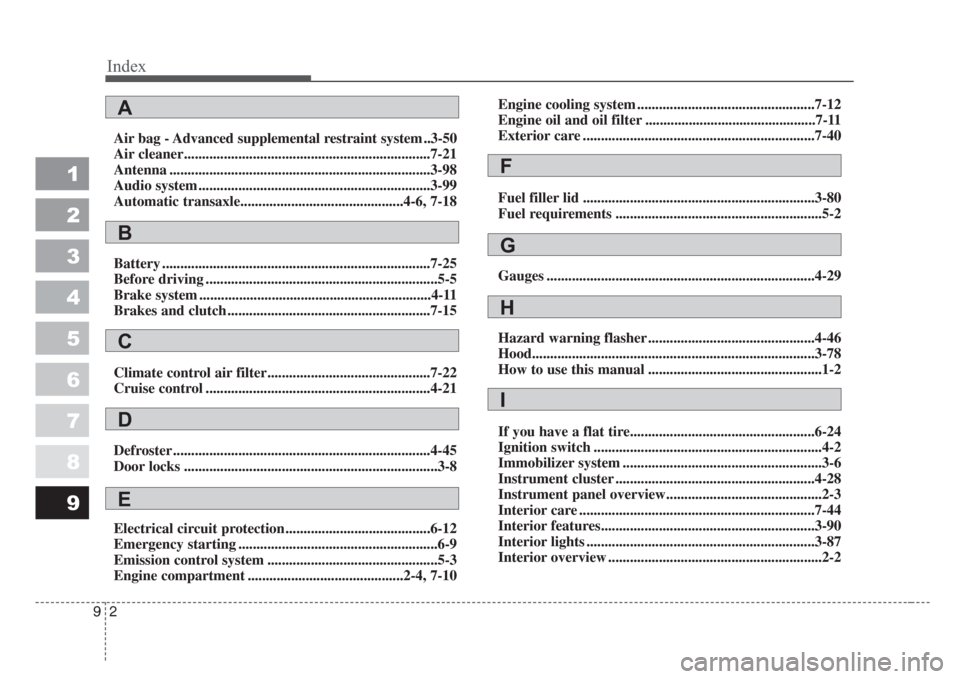
Index
2 9
1
2
3
4
5
6
7
8
9
Air bag - Advanced supplemental restraint system ..3-50
Air cleaner....................................................................7-21
Antenna ........................................................................3-98
Audio system ................................................................3-99
Automatic transaxle.............................................4-6, 7-18
Battery ..........................................................................7-25
Before driving ................................................................5-5
Brake system ................................................................4-11
Brakes and clutch ........................................................7-15
Climate control air filter.............................................7-22
Cruise control ..............................................................4-21
Defroster .......................................................................4-45
Door locks ......................................................................3-8
Electrical circuit protection........................................6-12
Emergency starting .......................................................6-9
Emission control system ...............................................5-3
Engine compartment ...........................................2-4, 7-10Engine cooling system .................................................7-12
Engine oil and oil filter ...............................................7-11
Exterior care ................................................................7-40
Fuel filler lid ................................................................3-80
Fuel requirements .........................................................5-2
Gauges ..........................................................................4-29
Hazard warning flasher ..............................................4-46
Hood..............................................................................3-78
How to use this manual ................................................1-2
If you have a flat tire...................................................6-24
Ignition switch ...............................................................4-2
Immobilizer system .......................................................3-6
Instrument cluster .......................................................4-28
Instrument panel overview...........................................2-3
Interior care .................................................................7-44
Interior features...........................................................3-90
Interior lights ...............................................................3-87
Interior overview ...........................................................2-2
A
B
C
D
E
G
F
H
I
Page 297 of 298
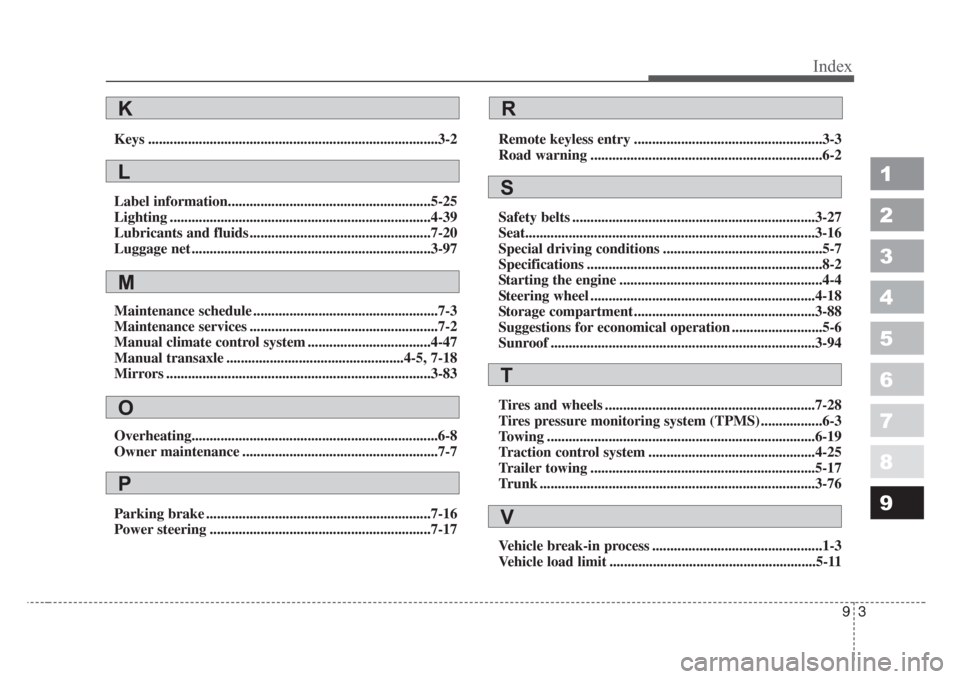
93
1
2
3
4
5
6
7
8
9
Index
Keys ................................................................................3-2
Label information........................................................5-25
Lighting ........................................................................4-39
Lubricants and fluids ..................................................7-20
Luggage net ..................................................................3-97
Maintenance schedule ...................................................7-3
Maintenance services ....................................................7-2
Manual climate control system ..................................4-47
Manual transaxle .................................................4-5, 7-18
Mirrors .........................................................................3-83
Overheating....................................................................6-8
Owner maintenance ......................................................7-7
Parking brake ..............................................................7-16
Power steering .............................................................7-17Remote keyless entry ....................................................3-3
Road warning ................................................................6-2
Safety belts ...................................................................3-27
Seat................................................................................3-16
Special driving conditions ............................................5-7
Specifications .................................................................8-2
Starting the engine ........................................................4-4
Steering wheel ..............................................................4-18
Storage compartment ..................................................3-88
Suggestions for economical operation .........................5-6
Sunroof .........................................................................3-94
Tires and wheels ..........................................................7-28
Tires pressure monitoring system (TPMS) .................6-3
Towing ..........................................................................6-19
Traction control system ..............................................4-25
Trailer towing ..............................................................5-17
Trunk ............................................................................3-76
Vehicle break-in process ...............................................1-3
Vehicle load limit .........................................................5-11
K
L
M
O
P
R
S
T
V